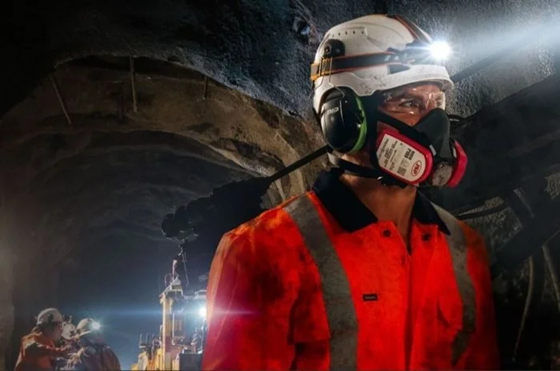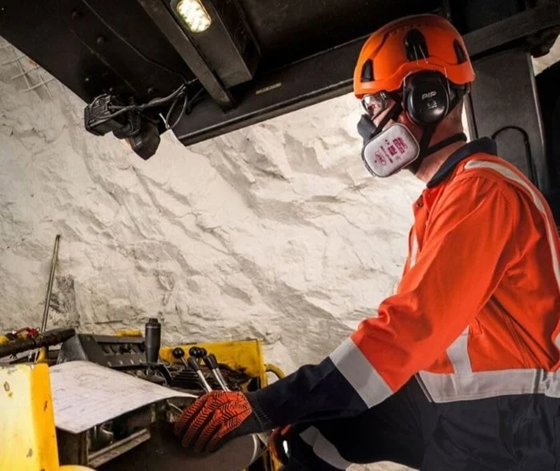Mining is a tough industry—workers regularly contend with extreme conditions, confined spaces, and heavy machinery. In such environments, protective gear isn’t optional; it’s essential. Helmets, boots, gloves, and clothing must offer reliable safety. When PPE is outdated or non-compliant, it can be nearly as dangerous as having no protection at all.
Advancements like digital technologies and automation have boosted safety and productivity in mining. But they also introduce new risks—ones that older protective equipment may not address. That’s why it’s critical to regularly assess whether current PPE is still doing its job. When it falls short, action must be taken quickly to ensure workers remain protected.
Evolving Risks in Mining, From Oil Lamps to Autonomous Vehicles
Mining PPE has traditionally focused on protecting workers from conventional hazards like falling debris, cave-ins, and exposure to chemicals and dust. But the landscape is changing. With the introduction of autonomous vehicles, intelligent sensors, and automated drilling systems, new challenges are emerging.
For instance, the Canadian government is aiming to automate a northern mine by 2050. This shift, using satellite imaging to remotely control operations, could significantly reduce human exposure to high-risk zones.1,2
In the US, the mining industry has already seen substantial investments in automation aimed at boosting both safety and efficiency. Major operations in states such as Nevada and West Virginia are now deploying remote-controlled drilling systems and autonomous haul trucks.
While these technologies are designed to limit direct human interaction with hazardous areas, there will still be a need for personnel to maintain, inspect, and supervise equipment. These roles demand specialized PPE tailored to modern risks, such as high-visibility clothing for machine recognition and dielectric gloves to guard against electrical shocks.
Keeping this equipment in good condition is just as important. PPE must be routinely inspected for damage or wear, and outdated gear should be replaced. Expired or malfunctioning PPE not only raises the risk of injury from unexpected failures, but it can also lead to fatigue, reduce worker efficiency, and cause operations to fall short of today’s strict safety standards.3,4,5

Image Credit: Protective Industrial Products, Inc.
Ensuring that Mining PPE Meets Current Requirements
When to Upgrade Equipment
Not all PPE needs to be replaced at the same time, but it's essential to upgrade equipment before it fails. Key moments to review and update gear include:
- After Significant Wear and Tear: If an item no longer provides full protection, it should be replaced immediately.
- When Safety Standards Change: Updated regulations may require PPE upgrades to remain compliant.
- With the Introduction of New Technology: Automation and other advancements can shift on-site risks, creating a need for more specialized protective gear.
- As New Materials Become Available: Innovative PPE designs can offer better durability, enhanced protection, and improved comfort, making them worth considering as upgrades.
Confirming that PPE is Still Safe
Staying ahead of PPE expiration requires ongoing vigilance. To ensure protective gear remains effective, consider the following practices:
- Conduct Regular Inspections: Look for signs of wear, damage, or fading, such as frayed gloves, cracks in helmets, or worn-out boot soles.
- Check Expiration Dates: Confirm that items like gloves, harnesses, and dielectric boots are still within their manufacturer-recommended service life.
- Stay Current with Regulations: Make sure all PPE complies with the latest industry standards, which may change over time.
- Listen to Worker Feedback: Employees who wear PPE every day are often the first to spot problems. If they report discomfort or signs of wear, that gear should be evaluated and, if necessary, replaced.
Ensuring that Expired PPE is Not Ignored
PPE naturally degrades over time, and while outdated gear might appear intact, it may fail at a critical moment. Relying on worn equipment increases the risk of serious injuries such as burns, electrical shocks, or arc flashes. Similarly, using faded high-visibility gear can make workers less noticeable, raising the likelihood of accidents.
Beyond the safety risks, companies that continue to use non-compliant PPE may also face legal liabilities, regulatory fines, and damage to their reputation.

Image Credit: Protective Industrial Products, Inc.
Choosing the Right PPE
PPE should not only meet minimum safety standards but also aim to enhance protection and performance while keeping pace with the evolving demands of mining environments.
Protective Industrial Products (PIP®) provides a comprehensive range of PPE solutions specifically designed to meet the safety needs of today’s mining operations.
Head Protection
Modern mining sites require impact protection from all directions—not just from above. ANSI Type II safety helmets, such as the Kilimanjaro™ and Traverse, offer advanced protection against both top and lateral impacts.
For sites that require at least Type I protection, JSP® Evolution® Deluxe mining hard hats are a dependable choice. These meet MSHA standards and feature built-in safety enhancements, including reflective stickers, lamp brackets, and optional integrated eye protection.
Head protection should be replaced or upgraded when:
- The shell shows evidence of dents, cracks, or UV degradation.
- The suspension system is stretched, worn, or no longer fits securely.
- The helmet is more than 5 years old or has sustained major impacts.
- Current gear is Type I, but the jobsite mandates Type II certification.
Respiratory Protection
Respiratory PPE is essential when working around airborne hazards such as diesel exhaust, silica dust, and particulates from blasting or drilling. PIP offers a range of options, including JSP® and Dynamic™ disposable respirators, as well as reusable facepieces with replaceable filters, available in both P100 and NIOSH N95 certified types.
Respiratory PPE should be replaced or upgraded when:
- Disposable respirators become soiled or difficult to breathe through, typically after one shift
- P100 or other filters in reusable respirators show increased breathing resistance or after exposure to high concentrations of contaminants
- Site conditions change, requiring enhanced protection
Hearing Protection
Long-term hearing damage is a serious risk in high-decibel areas, such as near blasting operations or heavy machinery. PIP® provides reusable and disposable earplugs and earmuffs suitable for a variety of noise levels and exposure durations.
Hearing protection should be replaced or upgraded when:
- Disposable earplugs become deformed, dirty, or lose elasticity. These are typically replaced after one shift.
- Reusable earplugs show evidence of cracking, wear, or when they no longer seal properly.
- Earmuffs have damaged headbands or worn cushions that compromise noise-blocking effectiveness.
Disposable earplugs can be paired with earmuffs for added protection where there is a need for higher noise reduction ratings or workers are subject to increased exposure levels.
Hand Protection
Handling sharp tools, jagged materials, and heavy equipment puts miners at constant risk of hand injuries. Up to 30 % of these injuries stem from using the wrong glove type or poor fit.
Cut- and impact-resistant gloves, like the Boss® Synthetic Leather Palm with TPR, are often required, and many jobs call for A5 cut protection and at least ANSI 138 Level 2 impact resistance.
Hand protection should be replaced or upgraded when:
- Gloves show evidence of tears, holes, or fraying
- There is a loss of grip, or coatings show evidence of wear
- Gloves lose flexibility or stiffen
- There is an unpleasant odor, even after washing
Upgrading to high-performance gloves can offer better durability, safety, and comfort over time.
Protective Workwear and Footwear
It is important that protective clothing and footwear provide comfort and mobility while shielding wearers against environmental hazards. Durable choices, such as industrial launderable Bisley® performance workwear, Pyrad® AR/FR gear, and electrical hazard-rated Puma® safety shoes, are designed to ensure the sustainability and protection necessary in modern mining operations.
Protective clothing and footwear should be replaced or upgraded when:
- Workwear shows evidence of holes, rips, or faded high-visibility and reflective striping
- AR/FR gear has been compromised by exposure to chemicals or heat
- Insulation or waterproofing fails, or garments become uncomfortable
- Footwear shows evidence of damaged toe caps, worn treads, or fails to meet updated safety standards
It is advisable to upgrade to high-performance, longer-lasting options in order to reduce replacement frequency and lower the overall cost of PPE.
Future-Proofing Worker Safety
Digital technologies and automation are driving improvements in both efficiency and safety across the mining sector, but human expertise remains vital, especially in complex or unpredictable environments.
To keep pace, it’s essential for manufacturers and mining companies to align PPE with emerging industry needs and advances in materials science. Doing so not only enhances worker protection and productivity but also helps ensure ongoing regulatory compliance.

Image Credit: Protective Industrial Products, Inc.
By adopting the latest PPE solutions from PIP®, mining operations can better safeguard their workforce, reinforcing the industry's long-term commitment to safety, innovation, and sustainability.
References and Further Reading
- Rogers, W.P., et al. (2019). Automation in the Mining Industry: Review of Technology, Systems, Human Factors, and Political Risk. Mining, Metallurgy & Exploration, 36(4), pp.607–631. https://doi.org/10.1007/s42461-019-0094-2.
- Onifade, M., Said, K.O. and Shivute, A.P. (2023). Safe mining operations through technological advancement. Process Safety and Environmental Protection, (online) 175, pp.251–258. https://doi.org/10.1016/j.psep.2023.05.052.
- MINING. (2018). Barrick Gold introduces autonomous trucks at Nevada mine. (online) Available at: https://www.mining.com/web/barrick-gold-introduces-autonomous-trucks-nevada-mine/.
- West Virginia University. (2019). WVU Today | A saving grace underground: WVU engineers utilize robots to improve mine safety. (online) Available at: https://wvutoday.wvu.edu/stories/2019/10/11/a-saving-grace-underground-wvu-engineers-utilize-robots-to-improve-mine-safety.
- West Virginia University. (2022). WVU Today | WVU engineers aim to improve safety with autonomous robotic inspection system for coal waste storage facilities. (online) Available at: https://wvutoday.wvu.edu/stories/2022/09/20/wvu-engineers-aim-to-improve-safety-with-autonomous-robotic-inspection-system-for-coal-waste-storage-facilities.
Acknowledgments
Produced from materials originally authored by Protective Industrial Products, Inc.

This information has been sourced, reviewed and adapted from materials provided by Protective Industrial Products, Inc.
For more information on this source, please visit Protective Industrial Products, Inc.